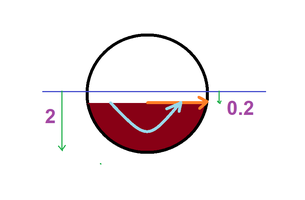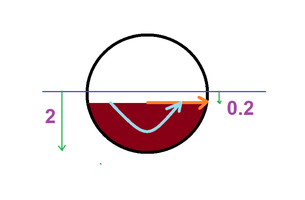If I have listened carefully to what Dan said in the first post, I would have quickly fixed my error. His genius idea of starting the integral with a circle instead of a volume was the start of igniting the spark. I hope that he will not see this post as he was right in other posts when he said "You think that you know something in Math, but really you know nothing".
You "do not know nothing" but in your push to keep moving forward you are missing a lot more than you seem to think that you are. As I've repeatedly told my Intro level Physics students, there are probably problems at the end of the chapters that can take me. (Not many, but I occasionally run into one that will take even me more than a week.). What do I do about that? I don't say, "Hey! I'm the guy that does QFT, so it doesn't matter.". No, I go back and review where the problem was. If I need to take some time out of my research to learn something I missed, or relearn something I have forgotten them that's what I need to do. I
like doing that, as it improves my understanding of Physics.
There is no shame in making a mistake. The shame is when you refuse to fix it. As I've told you many many times in the past: you need to go back to (at least) Calculus I and do a stiff review: you are missing basic concepts and are making mistakes on a level no one taking PDEqs should be making.
Stop pushing forward so fast and go back to the basics. It won't take you forever to do so, just a little more time that will be well spent.
-Dan
Addendum: Problem solving skills should probably be added to your list to review. The net is overflowing with suggestions. The following comments don't always work, but they help to give you overall structure. I'm sure you do at least some of this, but you might find something you can add.
1. Always draw a diagram and label all information you can gather from the problem statement. This adds a visual context, which your mind processes differently than logic or verbal.
2. Make sure to have your references handy, so that you don't have to get up in the middle of a problem and find a book.
3. If you are working on a topic, possibly even put a bookmark in certain sections of the chapter the problem comes from. Odds are that a text will give you some clue as to how to proceed.
4. When you ask questions, give your tutor everything that you have: the full problem statement and any work that you've done, even if that work is wrong. The less work you make your tutor do, the better they will be able to help you, and the faster they might be able to spot where you may have taken a wrong turn.
This one is specifically for you, though I've seen it in many other students:
5. Put your ego on the shelf: it only gets in the way. I don't really care that you have solved the Airy equation, that doesn't have anything to do with the problem at hand. Your pride is getting in the way of listening to what we are suggesting you do to solve the problem. It's not just the complaint about drawing a diagram from this thread; you have repeatedly ignored advice about how to do a problem because you insist that it can be done your way. Maybe it actually can't be done your way? Maybe there's a reason we are making the suggestion? Give it full consideration. After all,
you came to
us for help!
6. When you do your work, write out every step, no matter how small. It'much easier to catch your mistakes that way.
7. If you see that are having a specific difficulty during the solution, stop what you are doing and review the section or method that is troubling you, not just what immediately pertains to what you think you are having a problem with. You never know, the solution to your difficulty might be something that you haven't considered yet, not just that you might be screwing up the calculation somehow.
8. Try to keep it simple. (I admit that I have issues with this one. If there's a complicated approach to a problem, trust me, that's my first instinct!). The more involved your logic chain, the harder it will be to apply the concepts. Your impulse here was to write an integral. Certainly this can be (and was) done. It's good to know how to do it this way. But it's a lot simpler to just use some basic circle geometry.




